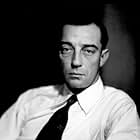PUNTUACIÓN EN IMDb
7,5/10
4,7 mil
TU PUNTUACIÓN
Añade un argumento en tu idiomaAfter waking up from his wacky dream, a theater stage hand inadvertently causes havoc everywhere he works.After waking up from his wacky dream, a theater stage hand inadvertently causes havoc everywhere he works.After waking up from his wacky dream, a theater stage hand inadvertently causes havoc everywhere he works.
- Premios
- 1 nominación en total
Buster Keaton
- Audience
- (as 'Buster' Keaton)
- …
Edward F. Cline
- Orangutan Trainer
- (sin acreditar)
Monte Collins
- Civil War Veteran
- (sin acreditar)
Virginia Fox
- Twin
- (sin acreditar)
Joe Martin
- Orangutan
- (sin acreditar)
Joe Murphy
- One of the Zouaves
- (sin acreditar)
Joe Roberts
- Actor-Stage Manager
- (sin acreditar)
Jess Weldon
- One of the Zouaves
- (sin acreditar)
Ford West
- Stage Hand
- (sin acreditar)
Argumento
¿Sabías que...?
- CuriosidadesThe multiple Busters on screen together were created in the camera, using a special lens with shutters to film only a portion of the scene at a time. Buster would perform one part, then the cameraman would crank the film back and open another shutter to film another part. A banjo player with a metronome helped Buster Keaton to perform precisely at the right time for each take.
- PifiasSometimes the background is visible through the elbow of Male Audience Member Buster, revealing the double-exposure technique used to film two Buster Keatons sitting side by side.
- Citas
Man in Audience: This fellow Keaton seems to be the whole show.
- Versiones alternativasThe 35mm print currently (2006) available for theatrical exhibition is slightly different from the DVD version:
- - There is a British Board of Film Censors approval title and an extra title mentioning the Raymond Rohauer collection.
- - The inter-titles are in a different font but contain the same text as the DVD version.
- - The "Written and Directed by" title credits Buster Keaton solely.
- - There is an out-of-sequence edit in the print. The scene where the Zouave guards walk out and Buster replaces them with street workers comes immediately after the sequence where Buster meets the twins. It begins right as the Zouave chief comes under the stage backdrop and confront Joe Roberts. The scene plays to the fadeout and then immediately cuts to the beginning of the monkey scene. At the end of the monkey scene, the backdrop confrontation begins and abruptly cuts right where it left off earlier in the film.
- ConexionesEdited into The Golden Age of Buster Keaton (1979)
Reseña destacada
Long before we became John Malkovich, an entire playhouse became Buster Keaton... and it's absolutely delightful. "The whole thing seems to be this Keaton fellow," says Keaton to Keaton dressed in drag (a much more attractive crossover than Jack Lemmon and Tony Curtis!). Indeed.
Oh, but that's not all! Nooo, why stop there when we have an antagonist to show? Because Malkovich is only in the head, and thus Keaton is but a dream. However, the real playhouse owner... he has a bone to pick with the little guy, in some of the most hilarious Keaton hijinks.
This is the consummate Buster Keaton short. From the magic and creativity of the beginning, to the chase scenes and guy-gets-girl later story, we follow him as he takes on and removes persona faster than the speed of a swinging chimp! Oh, and he gets to play that chimp too, and very very believably.
--PolarisDiB
Oh, but that's not all! Nooo, why stop there when we have an antagonist to show? Because Malkovich is only in the head, and thus Keaton is but a dream. However, the real playhouse owner... he has a bone to pick with the little guy, in some of the most hilarious Keaton hijinks.
This is the consummate Buster Keaton short. From the magic and creativity of the beginning, to the chase scenes and guy-gets-girl later story, we follow him as he takes on and removes persona faster than the speed of a swinging chimp! Oh, and he gets to play that chimp too, and very very believably.
--PolarisDiB
- Polaris_DiB
- 2 mar 2006
- Enlace permanente
Selecciones populares
Inicia sesión para calificar y añadir a tu lista para recibir recomendaciones personalizadas
Detalles
- Duración18 minutos
- Color
- Mezcla de sonido
- Relación de aspecto
- 1.37 : 1
Contribuir a esta página
Sugerir un cambio o añadir el contenido que falta

Principal laguna de datos
By what name was El gran espectáculo (1921) officially released in Canada in English?
Responde
























